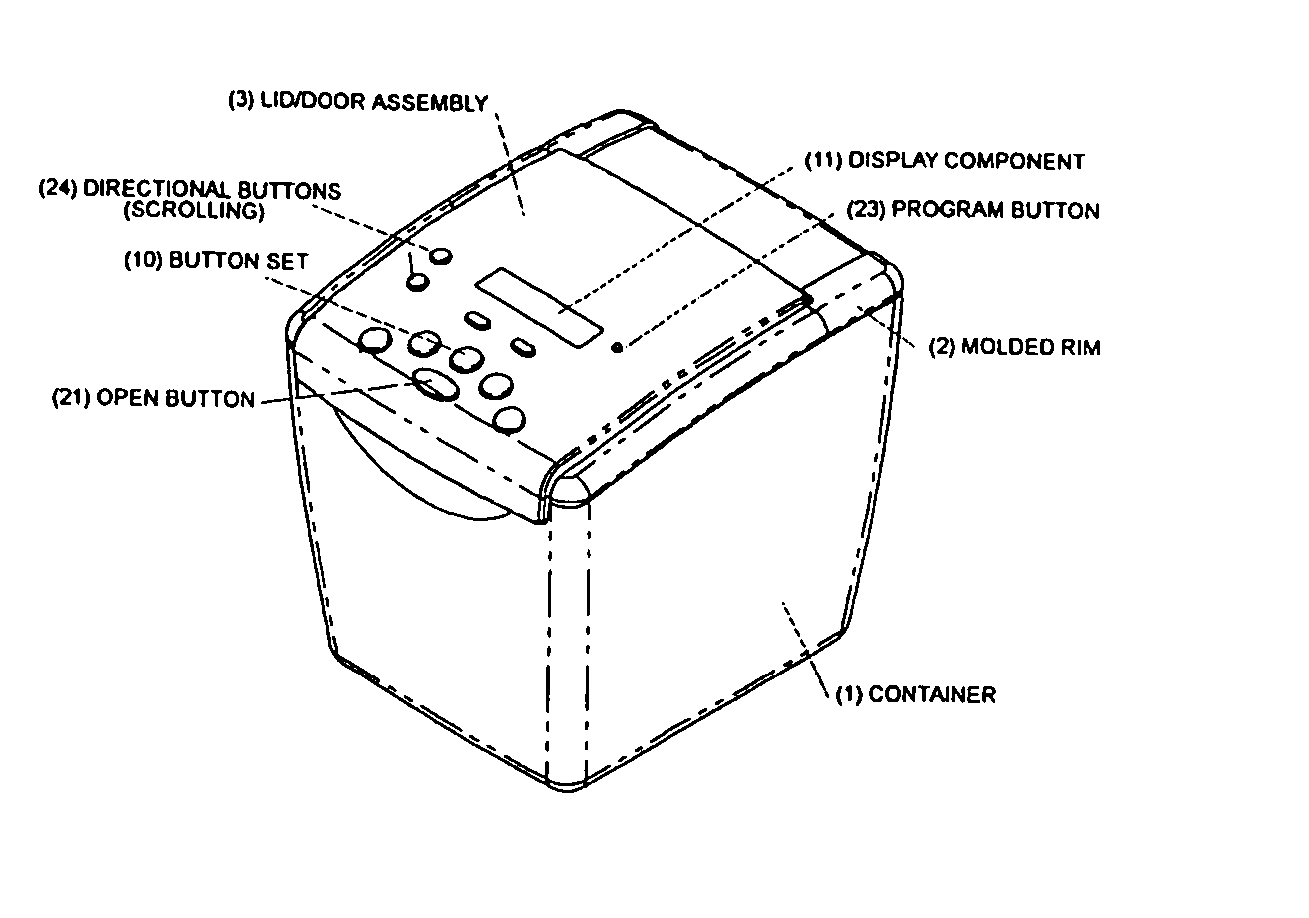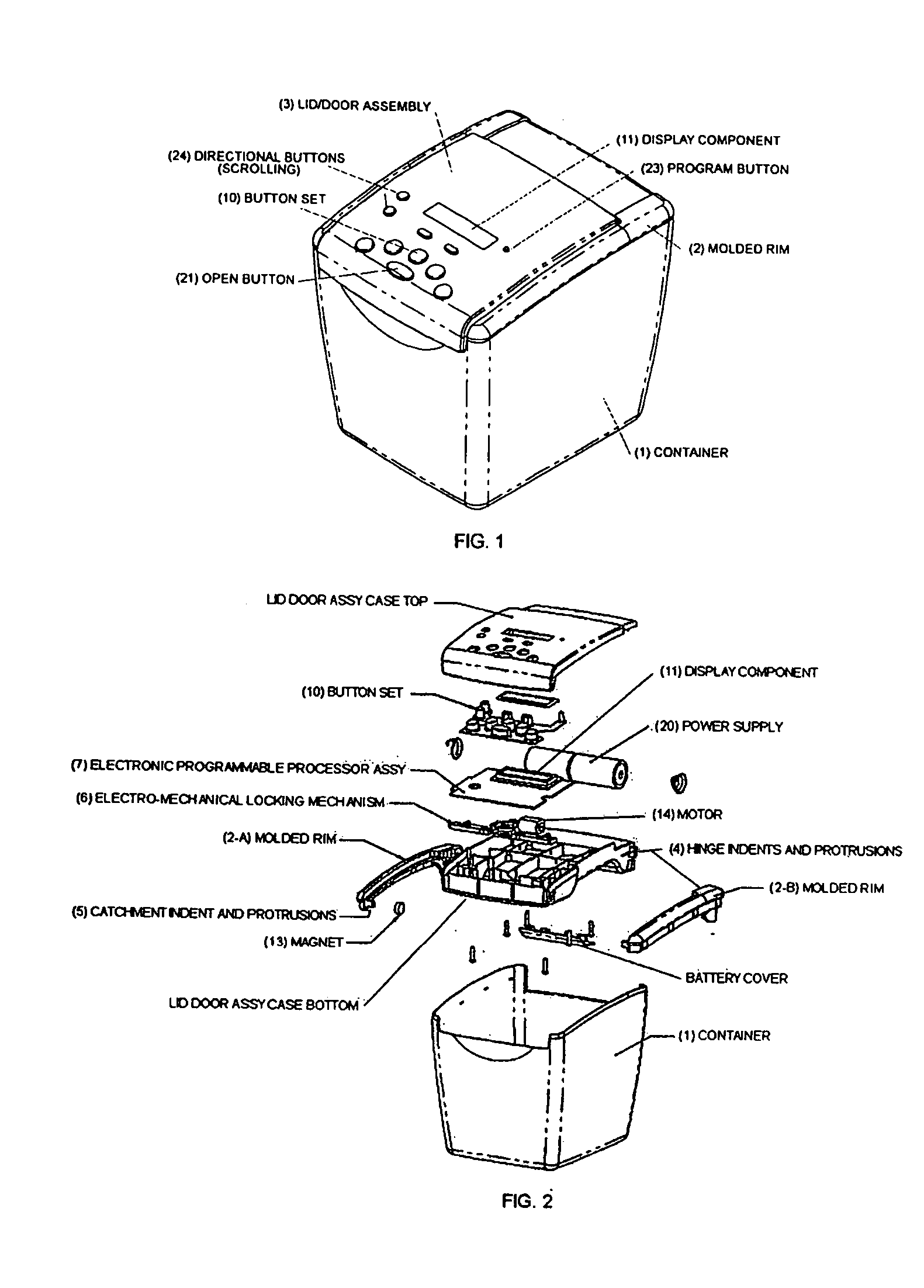It is known by those practiced in the art that human consumption of inappropriate quantities of certain products is detrimental to
human health, and that failure to successfully self-regulate the consumption of such products negatively impacts the areas of human self-image,
healthy weight maintenance, and
general health.
It is also widely known that children are particularly susceptible to the development of inappropriate consumption patterns when provided with unlimited access to “junk food,” leading to current
record levels of
obesity and similar
health problems in the United States, and contributing negatively to their health,
longevity, self image, and feelings of well-being.
Unfortunately, it is also known that a measurable and substantial percentage of the
population fails in that effort.
None of the devices disclosed in the prior art are effective in mandating compliance with a desired consumption pattern, and in assisting the user in his or her efforts to not only control
current consumption, but to develop better, more healthy, and more controlled patterns of consumption through successfully overcoming limited, controlled and conquerable impulses to consume.
Devices of this type which inherently and repeatedly present opportunities or temptations for the user to change, circumvent, or disable, the pre-defined access parameters during normal usage and / or at easily predictable intervals, fail in their designed and intended purpose because they cannot rigorously and strictly enforce the users desired and designed schedule of
accessibility.
Given that the user of such a device, in recognition of his own
weakness, has purchased and is using a device designed solely and specifically for the purpose of scheduling access to some product, any situation or feature, inherent to the design of such a device, that repeatedly could tempt the user to, or provides any means to, access the contents of the device outside of the user's desired and defined schedule of accessibility, is an unacceptable failing
weakness of a device that is designed purely to durably and repeatedly enforce a scope of behavior.
In particular, the inventor has identified, through the study of numerous recent scientific publications, a problematical human behavioral trait that directly undermines and contributes to the inevitable failure and ineffectuality of all prior art devices of this type.
The fundamental unsolved problem is that the human supply of the will to self regulate: (a) is of a diminishable nature; (b) is replenished by rest; (c) can be conserved; and (d) can be exercised by means of a strictly limited, and thus easy to resist, opportunity to positively overcome temptation.
Specifically, scientific articles published in the field of human psychology confirm that the human capacity to resist temptation is finite and diminishing, such that the act of resisting a temptation or “opportunity for failure” diminishes the
consumer's capacity to continue to resist future such temptations and opportunities.
The more opportunities for failure (or temptations) a
consumer confronts in his efforts to regulate consumption, the less capacity the consumer will retain to succeed in resisting other such opportunities, and the more likely it is that the consumer will fail in the long term effort to repeatedly regulate consumption and to develop better consumption habits through
habituation and positive reinforcement.
By repeatedly presenting such opportunities, and by creating the need to overcome them again and again in order to maintain the desired consumption schedule, such a device actually wears down the user's will to resist the presented temptations.
Rather than assisting in the development of the ability to resist such opportunities and temptations, such a device will actually contribute to the occurrence, degree, and frequency of periods of
weakness, and thus, in an self defeating cycle, to the inability of the user to resist the devices in-built opportunities and temptations to fail.
Devices presenting such opportunities are self defeating, and present opportunities and temptations that are too frequent, too numerous and too difficult to overcome over time, leading to failure.
There are no prior art devices that address or solve this problem.
As stated in the section of the study titled Implications: “Moreover, this resource (of mental energy) appears to be quite surprisingly limited.
Thus, these studies suggest that whatever is involved in choice and self-control is both an important and very limited resource.
These findings show that repeated testings of, and subsequent expenditures of, the reserve of the human will to self regulate, results in the subjects being increasingly less able to resist subsequent temptations.
As stated in the study's conclusion: “People have only a
limited capacity to control and alter their behavior, and this capacity appears to be vulnerable to depletion in the aftermath of strenuous use.” The conclusion further states that “when people squander their self-control strength in unproductive endeavors, they may find that their self-control breaks down in other unrelated spheres.”
In some instances high self esteem may cause a person to set unrealistic goals at the onset of a chosen path so that when failure results, the blame can be placed upon the difficulty of the path chosen rather than upon the performance of the subject.
In other instances, low self-esteem may cause a person to deliberately fail at some chosen task as a way to justify / prove their low opinion of themselves.
These scientific references demonstrate that prior art devices which require the user to repeatedly resist temptation and to make decisions and take actions in order to use the device, or which do not provide for any exercise at all of the user's will, do not present a solution to this previously misunderstood social / psychological problem, nor do they incorporate a means to tap into,
exploit and enhance a consumer's capacity to resist temptation as recognized and defined in the science of
human behavior.
Prior art devices which repeatedly rely upon the will of the user are self defeating.
Devices in this group inherently and repeatedly present opportunities or temptations for the user to change, circumvent or disable the pre-defined access parameters during normal usage and / or at easily predictable intervals.
The existence of such opportunities is an unacceptable failing and / or weakness of such a device because the device inevitably will provide such opportunities during periods of weakness when the user is mentally or physically unable to resist the temptation—the existence of these periods is a given, as a consumer who does not experience such periods of weakness would have little desire to purchase and use a device of this type.
And even if a user of a device of this type is successful in resisting opportunities or temptations to change, circumvent or disable the pre-defined access parameters during normal usage and / or at easily predictable intervals, the user does so by means of the consumption of some part of his finite supply of the will to self regulate, and does thus become, after repeated attempts to resist temptation, less and less able to resist additional opportunities and temptations.
Devices presenting such opportunities are self defeating, in that they present opportunities and temptations that are too frequent, too numerous and too difficult to overcome over time, leading to inevitable failure.
These arrangements are too
time consuming for the consumer to use, too expensive to manufacture, and use a less space efficient storage method rendering them impractical for general consumer usage.
Generally, products available at retail outlets are not packaged in manners that provide the uniformity required to work in these devices.
Uniform packaging is not a viable principle in this application.
Additionally, the variable nature of appropriate portioning makes this approach impractical for general consumer use.
A device of this type does not provide for any testing of the will of the user.
While such devices do not diminish the will to self regulate by tempting the user to consume, they also do not allow the user to succeed in his wishes to use his own will to self regulate, and thus exercise and enhance their will to self regulate resulting in the enhanced development and
repeatability of the desired behavior.
By eliminating all instances of temptation, these devices will not provide any increased volume of the will to self regulate as described in the science.
As a group, these prior art inventions are devoid of any means to enforce the indicated correct
course of action, and they instead rely purely upon the will of the user to resist impulses to act counter to the offered
course of action.
The prior art inventions in this group do not provide any means for
enforcement of limits placed upon the accessibility of the products and do not provide any durable and repeating means for
enforcement of limits placed upon the accessibility of the products.
By design, these inventions cause, by temptation, multiple testings and expenditures of the will to self regulate, and provide no means to provide the necessary periods of rest (periods of absence of temptations) that are necessary to enable the development of the available capacity of the will.
By not limiting temptations, these devices provide multiple opportunities to fail.
By not limiting temptations, these devices deplete the available will to self regulate until failure at the desired discipline results.
By attempting to control a very broad scope of behaviors these devices cause the user to be repeatedly tested and thus more likely to be depleted in their ability to resist impulses to act counter to their desired behavior.
Taken as a whole, the scientific studies and discussion of prior art devices outlined above indicate that devices disclosed in the prior art which do not afford the user any durably consistent and repeating
enforcement means that would aid the user in resisting the types of urges and counterproductive motivations that are the causes of the original negative behavior pattern, are not effective in durably restricting access to the content of the devices, nor in the modification of
human behavior toward the development of a more desirable pattern of consumption and “willpower.
None of the prior art devices disclose this capability.
 Login to View More
Login to View More  Login to View More
Login to View More 


